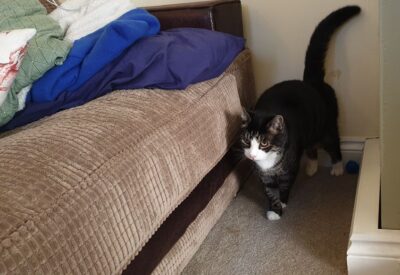When a cat lives with you in your home, you develop a relationship, just as you would with another human. Such relationships can be challenging, since the cat does not speak your language. Therefore, how can you learn how to deal with common cat behavior problems?
You must learn to monitor the situation carefully and read the cat’s body language. You must also become aware of normal cat behaviors, as perhaps the cat merely exhibits his natural tendencies, unaware that he breaks some household rule that you may have.
Dealing with behavior problems often becomes a learning experience for both you and your feline friend, as you try to reach some compromise. For example, it’s normal for a cat to scratch, thus keeping those tools we call claws ready for use when needed.

It’s normal for your cat to mark his territory. It’s kitty’s way of fencing the space he calls his own. No real estate agent sells him a deed. He marks his own property boundaries. He might show aggression toward another cat, or even toward a human, if it becomes a security issue.
Let’s look at some specific situations to see if we can find a ready solution. The following issues may be some that you face.
Scratching In An Inappropriate Location
You just love your beautiful new sofa, and your cat thinks it’s pretty wonderful, too. He has a couple of reasons: One, it’s a new place to scratch, allowing him to leave pheromones from his paws on that new object, thus making it his as well as yours.
Also, it might seem to kitty to provide an excellent place to sharpen those claws, an important part of his essential duties. How do you solve this problem? Redirection. Provide good scratching posts, both horizontal and vertical, that your cat can use for such chores.

Throw a cover over the new sofa. You might try claw covers, which you can obtain from your vet. They have to be replaced regularly, but they can help.
My cat, Mocha, has a couple of ways to fill this scratching need. He has an upright scratching post that he uses regularly. If you have such a post, you can encourage your cat to use it by sprinkling a little catnip on it.
Mocha also has a horizontal post that he uses every morning. It might not be a solution for everyone but it works for us. My box springs came from the local second-hand store, at a whopping cost of $10.00. Every morning, Mocha pulls himself along that box springs with his claws, gaining exercise and fulfilling scratching needs at the same time.
The roof above my front deck has 4×4 supports. One of these has permanent markings from Carlos, the last kitty resident. He used it many times to sharpen his claws to hunting readiness.
Urinating Outside The Box
Cats love cleanliness, and one reason kitty may not use that box stems from its not being clean enough to meet his standards. Keep that box clean — at least twice a day. I clean Mocha’s box every time I see that he’s used it.

Some cats do not like covered boxes, probably because the smell gets trapped inside. My old cat, Pogo, developed an outside-the-box habit because he didn’t like that covered space. When he moved in with me, he never peed outside his uncovered box.
Other factors could cause this behavior. It could stem from an infection. Sometimes it takes a visit to the vet to rule out some problems.
Night-time Yowling
Oh, this one can cause you great unhappiness, especially if you just relaxed into a good sleep, and the cat starts yowling at top volume. This problem occurs partly because a cat is crepuscular, meaning kitty’s most active time occurs at dawn or dusk.
Sometimes you can solve the problem by instituting an active play session just before you go to bed. Furnish toys that the cat can enjoy when you are trying to sleep. If he likes to hunt at night and you let him out to do so, make sure the cat door is open. Perhaps he wishes attention.

Mocha spent many nights yowling at about 4:30 a.m. I finally solved that problem in the following way: Right before bed, I put two servings of food in his dish: One provides a small serving of his kibble, which he gobbles up immediately. I also include about a half-portion of wet food, fresh from the fridge; thus, very cold.
He won’t eat the cold food right away, but in the wee hours it warms up to room temperature. Then he eats it and does not yowl at me to get up and feed him.
Overgrooming
Granted, a cat spends a great deal of time in grooming his coat — after all, it serves as his one article of clothing, and certainly can’t be removed and thrown in the washer. So, he washes a lot. After all, cleanliness becomes all-important to the cat.
However, what if this grooming becomes excessive? If you feel your cat does not experience stress or anxiety, the cause for this excessive licking, resulting in the loss of a great deal of fur, may stem from a physical problem. The cat may experience pain. Check with your vet to make sure.

Overgrooming can often stem from stress, however. Again, consider my old Pogo cat. After his 7 1/2 month stay in the animal shelter, his stress reached the maximum level. When I brought him home, he had pulled all the hair from his stomach, off his ears, and in tracks down his legs.
Once he regained a stress-free home, he began to recover. All the fur grew back in, and he again became relaxed and content. Interesting, though, that at first, he’d go to sleep at night and dream he was back in that place. He’d start pulling out fur in his sleep. I’d stroke him, talk to him softly, and soon he’d go back to a restful sleep.
How Do You Deal With An Aggressive Cat?
A cat can display aggressive behavior for many reasons. Perhaps the kitten did not receive proper socialization at an early age, with the result that humans represent a threat or cause fear. Perhaps the cat never learned to curb aggressive behavior, and believes that rough play is normal.

Perhaps the cat had a previous negative or traumatic experience with some person. The result could cause him to be fearful and defensive when in contact with humans.
Aggressive behavior needs management. A cat bite might become a serious infection. These suggested guidelines might help:
- Teach a cat at a young age that aggressive behavior will not be accepted.
- Do not give physical punishment, as this may actually reinforce the negative behavior
- Consider asking your vet about medications
- If the cat shows signs of becoming aggressive, go away and leave him alone
- Avoid potential situations that may bring on aggression
- Separate cats acting aggressively toward each other and reintroduce slowly, using positive reinforcement. Food treats can prove very helpful.
I chose this topic for today’s post because I have a problem with Mocha and wanted a solution. No exact information came forth. I’ve devised a solution, but perhaps you can help me find a better one.

Here’s what happens: He wants something and I won’t give it to him, so he grabs my leg and starts to bite it. After all, he’s the Alpha male of the household, and even though I’m the Alpha female, he believes his word should be law.
This situation normally occurs when he wants out and I won’t let him out. Here’s what I do: When he attacks the leg, I shove him away, and say, “bad cat.” Then he runs. No, I don’t kick him — I’d never kick my cat. I just shove him with my foot. It works, but I wonder if there’s a better solution. Let me know if you have suggestions.
Conclusion
These topics represent a few of the behavioral issues you may encounter. There might well be others. May you find solutions that work in your household.
A cat becomes a most interesting companion. I often marvel at Wendy Christensen’s book title, “Outsmarting Cats.” So true — The cat has a great deal of “smarts” and will keep you on your toes trying to stay one jump ahead of him. Do enjoy your relationship!
References I used for this post:
www.petmd.com/cat/slideshows/9-common-cat-behavior-problems-and-how-fix-them cats.com/cat-behavioral-problems www.pumpkin.care/blog/common-cat-behavior-problems/ thesprucepets.com/cat-behavior-problems-554077 vet.cornell.edu/departments-centers-and-institutes/cornell-feline-health-center/health-information/feline-health-topics/feline-behavior-problems-aggression

